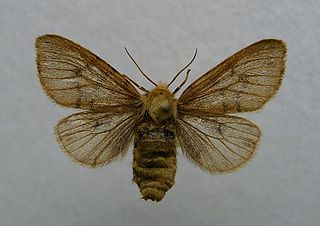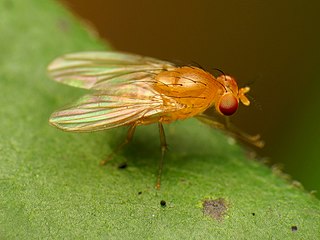Related Research Articles

Bartlettina sordida, the purple torch or blue mist flower, is a flowering plant which is endemic to cloud forest habitats in Mexico. It was formerly classified in the genus Eupatorium.

The moorland chat, also known as the alpine chat or hill chat, is a species of songbird in the Old World flycatcher family. It is endemic to north-east Africa where it is common in its habitat. It lives at high altitudes on moors and grassland, usually above 3,400 m (11,100 ft), but can live as low as 2,100 m (6,900 ft). It has a short tail and long legs. It is bold and will approach people.

The western hooded pitta is a passerine bird in the family Pittidae. It is common in eastern and southeastern Asia and maritime Southeast Asia, where it lives in several types of forests as well as on plantations and other cultivated areas. It is a green bird with a black head and chestnut crown. It forages on the ground for insects and their larvae, and also eats berries. It breeds between February and August, the pair being strongly territorial and building their nest on the ground. Incubation and care of the fledglings is done by both parents. The bird has a wide range, and the International Union for Conservation of Nature has assessed its conservation status as being of "least concern". It was formerly considered to be conspecific with the Nicobar hooded pitta, the Minahasa hooded pitta, the eastern hooded pitta and the Biak hooded pitta.

Bartlettina is a genus of flowering plants in the family Asteraceae. They are native to tropical regions of Mesoamerica and South America. The genus was erected to house several plants separated from genus Eupatorium.

The Veragua cross-banded tree frog is a species of frog in the family Hylidae found in Colombia, Costa Rica, Honduras, Nicaragua, and Panama. Its natural habitats are subtropical or tropical moist lowland forests, subtropical or tropical moist montane forests, rivers, plantations, rural gardens, urban areas, heavily degraded former forests, and canals and ditches. Scientists have observed it as high in the hills as 1525 meters above sea level.

The orange-headed tanager is a species of bird in the family Thraupidae. Native to South America, it is found in Argentina, Bolivia, Brazil, Colombia, Ecuador, Paraguay, Peru, and Venezuela, where it inhabits successional vegetation, cerrado, riparian forest, shrub, brush, and open woodland. Males of the species have sandy-gray upperparts, cinnamon to buff underparts, white on the center of the lower breast, belly, and tail, and rufous-orange and yellow heads. Females are similar but duller.
Nectandra sordida is a species of plant in the family Lauraceae. It is endemic to Bolivia and Peru. It is threatened by habitat loss.
Syngeneta is a moth genus, belonging to the family Tineidae. It contains only one species, Syngeneta sordida, which is found in Tanzania.

Catocala sordida, the sordid underwing, is a moth of the family Erebidae. The species was first described by Augustus Radcliffe Grote in 1877. It is found in North America from Saskatchewan east to New Brunswick and Prince Edward Island and south through Maine and Connecticut to Florida, west to Texas and north to Manitoba.
Batillaria sordida is a species of sea snail, a marine gastropod mollusc in the family Batillariidae.

Diaphora sordida is a moth of the family Erebidae first described by Jacob Hübner in 1803. It is found in the Alps, the Pyrenees and the Apennines.

Hymenoptychis sordida, the pneumatophore moth, is a moth of the family Crambidae. The species was first described by Philipp Christoph Zeller in 1852. It is known from Australia, southern and South-East Asia, several Pacific islands, Seychelles, South Africa, Madagascar and the United Arab Emirates.
Velora is a genus of longhorn beetles of the subfamily Lamiinae.
Velora alboplagiata is a species of beetle in the family Cerambycidae. It was described by Per Olof Christopher Aurivillius in 1927 and is known from Australia.
Velora curvifascia is a species of beetle in the family Cerambycidae. It was described by Per Olof Christopher Aurivillius in 1927.
Velora ciliata is a species of beetle in the family Cerambycidae. It was described by Stephan von Breuning in 1931. It is known from Australia.

Neogriphoneura sordida is a species of fly in the family Lauxaniidae.

Banasa sordida is a species of stink bug in the family Pentatomidae. It is found in North America.

The small-headed elaenia, also known as the Brazilian elaenia, is a species of bird in the family Tyrannidae, the tyrant flycatchers. It is found in southeastern Brazil, eastern Paraguay, and northeastern Argentina.

Triatoma sordida is an assassin bug within the genus Triatoma. This species consists of three subspecies. Also referred to as kissing bugs, T.sordida are most well known for their role as a secondary vector of Chagas Disease. Inhabiting warm, dry climates, T.sordida are widely distributed throughout South America, occupying houses, farming structures, and wild habitats. Pest control is currently focused on insecticide application. However, biological controls utilizing fungi appear promising.
References
- ↑ BioLib.cz - Velora sordida. Retrieved on 8 September 2014.